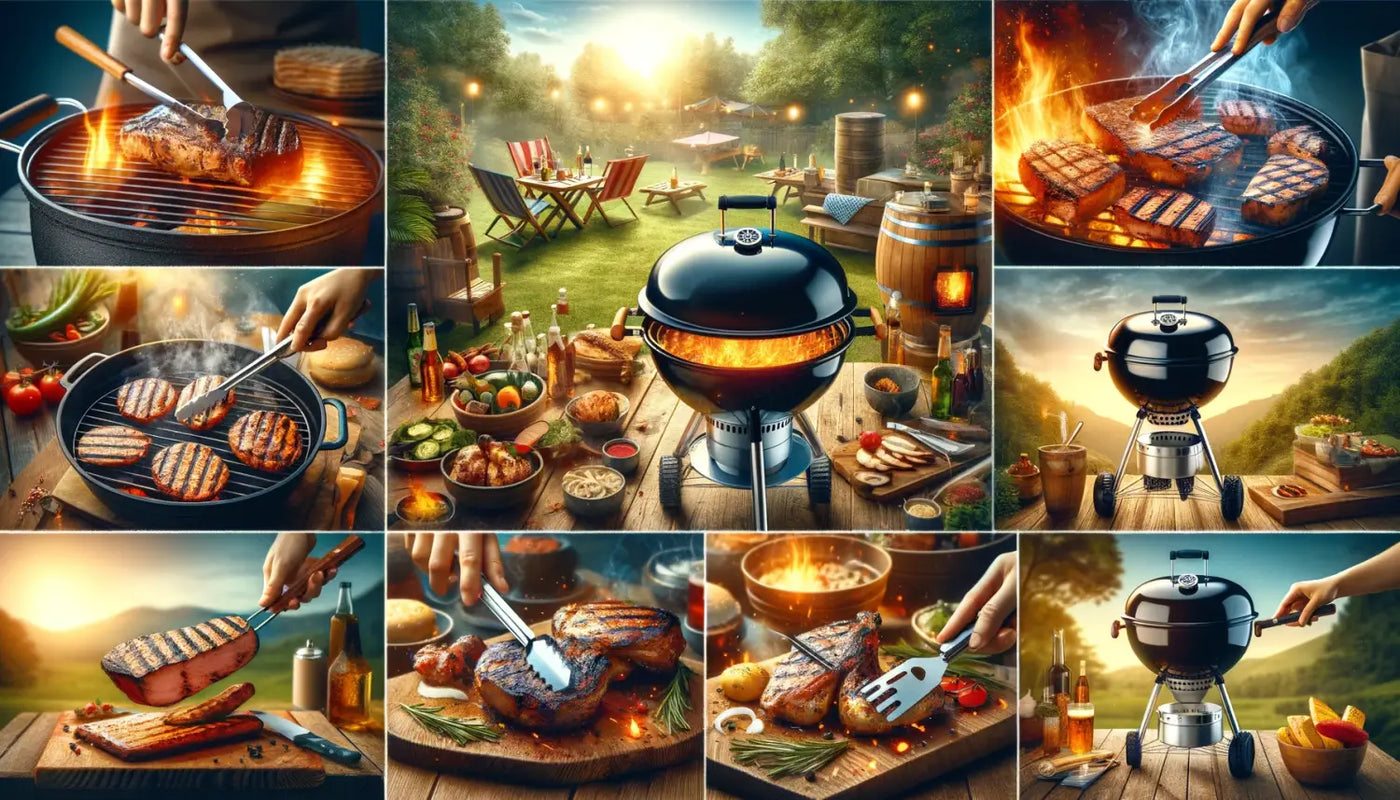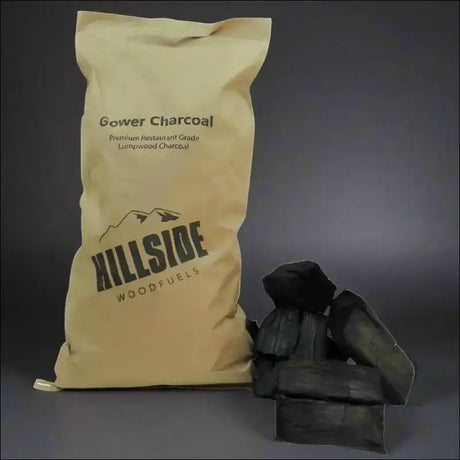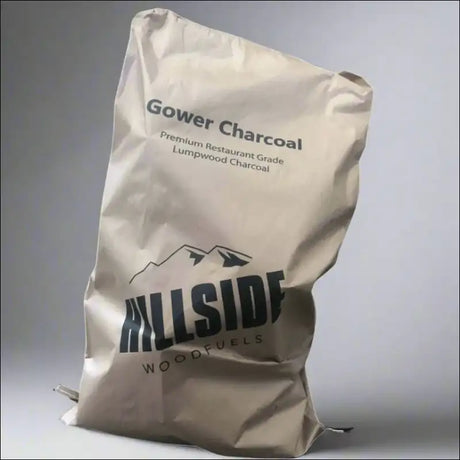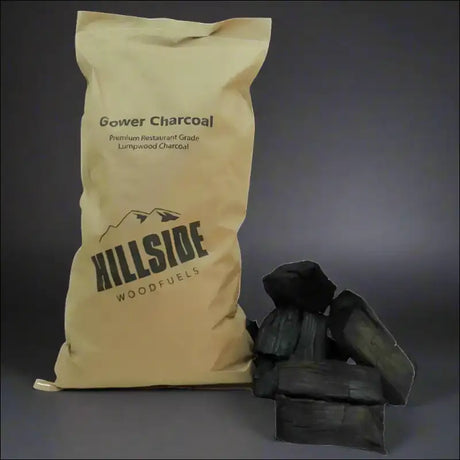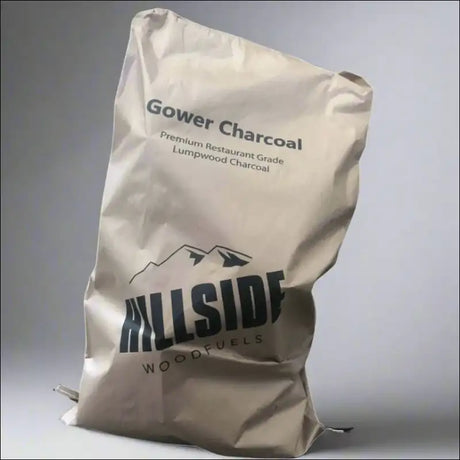Charcoal has been labelled 'black gold' by culinary enthusiasts worldwide for good reason. It's the backbone of traditional barbecuing, offering a primordial connection between fire, wood, and flavour that modern grilling technologies have yet to surpass.
The history of charcoal
The use of charcoal for cooking dates back millennia. Traces of charcoal have been discovered in caves occupied by Neanderthals, and charcoal remnants have been found on cooking sites of early Homo sapiens. This rich history is not only captivating but also underscores charcoal's enduring utility in human culture.
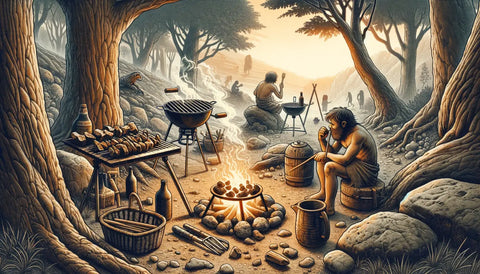
Initially, charcoal was used for its ability to produce a high-temperature, smokeless flame—ideal for smelting metals. However, its use in cookery quickly became apparent. From the simple campfires of early humans to the sophisticated asadores of South America, charcoal has been used around the globe to infuse food with a unique smokiness and rich depth of flavour that is unrivalled.
The benefits of charcoal grilling
Many enthusiasts argue that no gas grill can replicate the authentic taste that charcoal imparts to the food. The high-temperature searing capability of charcoal grills makes them especially suited for creating the much-coveted 'Maillard reaction,' where amino acids and reducing sugars in food give rise to complex flavours and appetising browned surfaces.
Charcoal grilling is also known for its versatility. Whether you're aiming for a slow, sustained cook or a quick, searing heat, charcoal grills provide hands-on control over the cooking process, allowing chefs to adjust the heat by simply manipulating the charcoal placement. It's this control, alongside the inherent flavour-enhancing properties of the wood, that makes charcoal an artisanal choice for outdoor cooking.
The science of charcoal production
Charcoal is produced through a process known as pyrolysis, the thermal decomposition of organic materials—in this case, wood—in an oxygen-limited environment. This scientific process is what transforms ordinary wood into the remarkable fuel source that gives our food that distinct, grilled taste.
Types of Wood for Charcoal
Hardwood charcoal
When it comes to high-quality grilling, hardwood charcoal is typically the aficionado's choice. Hardwoods like ash, oak, hickory, and maple—found in abundance across the UK—are dense and have a slower burn rate, resulting in longer-lasting and hotter fires.
Softwood charcoal
Compared to their hardwood counterparts, softwoods are less commonly used for grilling due to their resin content, which can affect the flavour of the food. However, softwoods like pine and fir ignite more quickly and are sometimes used in the production of specialty charcoals for specific purposes, such as quick grilling sessions or for their distinctive aromatic qualities.
Lump charcoal
Lump charcoal is the purest form of charcoal and is highly prized for its ability to reach high temperatures and produce minimal ash. It's made from hardwoods and retains the organic shape of the wood it originated from. Because it's free from binders and fillers, lump charcoal is favoured by purists who seek the pure, clean taste of grilled food.
Briquettes
Briquettes are a manufactured charcoal product created from wood by-products and often include fillers and binders, such as starch. Though they burn more consistently and for longer periods than lump charcoal, they can impart an unwanted flavour to food from the additives. That's why at Hillside Woodfuels, we focus on offering natural and environmentally friendly charcoal options that align with our dedication to purity and quality.
The Charcoal Production Process
Carbonization
The carbonization step is where wood transitions into charcoal. In controlled environments, wood is heated to temperatures between 400°C to 700°C. This process drives out moisture and volatile gases, leaving behind carbon-rich black charcoal. The careful control of temperature and oxygen is pivotal; too much oxygen, and the wood would simply burn to ash, too little, and the process would stall.
Activation
This step is more relevant for industrial applications where charcoal is used for filtration and purification purposes, as in water filters or air purification systems. Activation is achieved by heating the already carbonized wood at even higher temperatures with certain chemicals, which greatly increases the porosity of the charcoal, enhancing its absorptive properties.
Cooling
After carbonization, cooling is an essential step. Charcoal must be cooled down slowly in the absence of oxygen to prevent it from catching fire. After cooling, it's ready to be packed and distributed for various uses, including grilling.
The Properties of Charcoal
Density
Charcoal's density is far less than that of the original wood, given that most of the non-carbon elements and water have been removed. This creates a lightweight but energy-dense fuel source.
Hardness
Charcoal's hardness can vary depending on the type of wood used and the production process. Higher quality hardwood charcoals will often be harder and less likely to crumble, which is an important consideration for grilling.
Porosity
The porosity of charcoal makes it an excellent fuel. Its internal structure allows for airflow, which is critical for maintaining fire. The porous nature of charcoal also aids in the absorption of liquids and gases, which is why it's often used in filtering applications.
Ash content
Ash content is a measure of mineral residue left after charcoal has been fully combusted. High-quality charcoal tends to have low ash content, enabling better airflow during grilling and making clean-up easier.
The Chemical Composition of Charcoal
Carbon
Carbon is the primary component of charcoal, comprising approximately 70-90% of its weight. The high carbon content is responsible for the fuel's energy efficiency and ability to produce a consistently hot flame.
Hydrogen
Hydrogen, making up roughly 0.1-0.5% of charcoal, is part of the complex organic molecules in wood. Most hydrogen is released as water vapour during carbonization.
Oxygen
Oxygen is found in charcoal at levels of 1-3%, contained within the molecular structure of the carbonized material. It is largely expelled during the initial heating process.
Ash
Ash, the non-combustible mineral content left after burning, is minimal in high-quality charcoal, usually below 5%. This contributes to a longer burn time and consistent heat production.
How Charcoal Works
Heat transfer
Charcoal grilling primarily relies on radiant heat, where heat is transferred directly from the glowing coals to the food. This type of heat is ideal for creating crispy exteriors and perfectly cooked interiors. Additionally, the convective heat of the hot air circulating within a closed grill contributes to cooking, especially for thicker cuts of meat.
Smoke production
As the drippings from the food hit the hot charcoal, they vaporize, producing smoke that circulates around the food, imparting that distinctive, smoky barbecue flavour. This complex interplay of heat and smoke is what sets charcoal grilling apart from other cooking methods.
Flavor enhancement
Within charcoal, there are compounds like lignin, which when combusted, releases flavourful compounds. The different woods used to produce charcoal can add a range of subtle flavours, enhancing the culinary experience. A range of fragrant wood products are available to discerning grillers aiming to achieve a specific taste profile.
Charcoal Grilling Techniques
Direct grilling
Direct grilling involves placing food directly over the hot coals, providing intense, direct heat perfect for searing meats and achieving a flavorful crust. Short cooking times are characteristic of this method, which is ideal for thinner cuts of meat, skewers, and vegetables.
Indirect grilling
For larger cuts of meat, indirect grilling is the superior method. Here the charcoal is situated to one side of the grill or around a drip pan, with the food placed away from the coals. This allows the food to cook slowly through convective heat, similar to an oven.
Two-zone grilling
The two-zone method combines direct and indirect grilling. By arranging the coals on one side of the grill to create a hot zone and leaving the other side coal-free for a cooler zone, chefs can move food between the zones as needed. This technique affords superb control over the cooking process, from searing to gentle roasting.
Here's a practical guide to setting up your grill for both the direct and indirect methods:
| Technique | Charcoal Placement | Ideal for Cooking | Temperature Range | Additional Details |
|---|---|---|---|---|
| Direct | Even layer under grill grate | Steaks, kebabs, burgers, vegetables | High (230-290°C) | Ideal for quick cooking; best for foods needing searing or less than 30 minutes of cooking time. |
| Indirect | To the sides or in a ring around edges | Whole chicken, roasts, large cuts of meat | Medium (150-230°C) | Suitable for slow cooking; perfect for foods requiring longer cooking times or prone to burning. |
| Two-Zone | Hot zone on one side, no coals on other | Mixed grilling, various food types | Varies by Zone | Provides flexibility; allows for searing on the hot side and slower cooking on the cool side. |
| Smoke Roasting | Sparse coals with wood chips added | Brisket, ribs, smoked fish | Low to Medium (110-150°C) | Combines indirect grilling with smoking; for tender, flavor-infused meats requiring several hours. |
| Rotisserie | Indirect heat, coals at the sides | Whole poultry, gyros, roasts | Medium (150-230°C) | Utilizes a rotating spit; ensures even cooking and self-basting, ideal for large, round cuts of meat. |
Charcoal Grilling Tips
Master the nuances of charcoal grilling to ensure every barbecue is a triumphant feast.
Choosing the right charcoal
The choice of charcoal significantly affects the flavour and efficiency of your grilling. Opt for high-quality charcoal such as Hillside Woodfuels’ lump charcoal for a cleaner, chemical-free taste and an authentic grilling experience.
Lighting charcoal
Lighting charcoal can be accomplished using starters like chimney starters or electric starters for a more efficient and eco-friendly approach than lighter fluids. Allow the coals to burn until they're covered with a fine, light grey ash before you start cooking, indicating that they're hot enough for grilling.
Controlling heat
Controlling the heat of a charcoal grill is about managing air flow. The grill's vents can be opened to increase oxygen and raise the temperature, or closed to limit oxygen and lower the heat. It's vital to learn how your specific grill responds to these adjustments.
Preventing flare-ups
Flare-ups can be both dangerous and detrimental to food quality. To prevent these sudden bursts of flame, keep a portion of the grill coal-free to move food to in case of a flare-up. Also, trim excess fat from meats, use tongs instead of piercing the meat, and avoid sugary sauces until the last few minutes of cooking.
Charcoal Grilling Recipes
A selection of recipes to showcase the breadth of charcoal grilling's potential:
- Burgers: A quintessential grill favorite, burgers benefit greatly from the direct grilling method. For luxurious burgers, try using a blend of chuck and sirloin with a fat content of around 20% for juiciness and flavour. Grill for 3-4 minutes per side for medium-rare.
- Steaks: For a sublime steak, bring your meat to room temperature, season generously, and employ the two-zone technique: sear over direct heat for a crust and then move to the indirect zone until the desired doneness. A good rule is 3 minutes per side for direct heat and an additional 4-6 minutes in the indirect zone for a medium-rare rib-eye.
- Chicken: Brine your chicken to retain moisture, and consider a two-zone setup for even cooking without burning the skin. Whole chickens can benefit from indirect heat, cooked to an internal temperature of 74°C, as verified by a meat thermometer.
- Fish: Fish requires gentle heat. Use a well-oiled grill and a fish basket if available, and cook fillets over indirect heat for delicate, flakey perfection. Whole fish can be grilled over direct heat for a crispy skin, but always monitor closely to avoid overcooking.
- Vegetables: Vegetables transform on a charcoal grill. Asparagus, bell peppers, and courgettes are particularly grill-friendly. A quick toss in olive oil, salt, and pepper and a few minutes over direct heat is all you need for a delightful, charred side dish.
Here are suggestions for the ideal grilling time for various foods:
| Food Item | Grill Method | Grilling Time | Additional Notes |
|---|---|---|---|
| Burgers | Direct | 6-8 minutes | Flip once; ideal internal temperature is 71°C for well-done. |
| Steaks | Two-Zone | 10-15 minutes | Sear on hot zone, then move to cooler zone; rest for 5 minutes after cooking. |
| Chicken | Two-Zone | 30-40 minutes | Use indirect heat after searing; ensure internal temperature reaches 74°C. |
| Fish Fillets | Indirect | 10-15 minutes | Gentle heat prevents breaking; cook until fish flakes easily with a fork. |
| Vegetables | Direct | 5-10 minutes | Times vary by vegetable; some may need wrapping in foil. |
| Pork Chops | Direct | 10-15 minutes | Flip once midway; cook until internal temperature is 63°C. |
| Sausages | Two-Zone | 15-20 minutes | Start on indirect heat, then finish on direct for a crispy exterior. |
| Ribs | Indirect | 2-3 hours | Low and slow approach; wrap in foil for part of the time for tenderness. |
These recommendations are guidelines; always use a meat thermometer to ensure safe cooking temperatures are reached.
Charcoal Grilling Safety
- Proper storage: Charcoal should be stored in a cool, dry place to maintain its burning qualities. Ensure bags are sealed to prevent moisture absorption. View our storage solutions for tips on keeping your charcoal in prime condition.
- Fire safety: Grill in a well-ventilated area away from combustibles. Have a fire extinguisher or water source handy in case of emergency, and never leave the grill unattended when in use.
- Avoiding carbon monoxide poisoning: Charcoal grills produce carbon monoxide, a colorless, odorless gas that can be deadly. Always grill outdoors, not in enclosed spaces, even if they're ventilated, to prevent carbon monoxide build-up.
The Future of Charcoal Grilling
Innovation and tradition meld in the continuously evolving world of charcoal grilling. Here's a glimpse into the future:
- Sustainable Charcoal Production: The rising interest in sustainability is shaping the way charcoal is produced. Consumers increasingly demand environmentally friendly firewood and charcoal, and producers respond with methods like coppicing and sustainable forest management to ensure the ongoing health of our woodlands.
- Enhanced Grill Designs: Grill manufacturers are ever-improving designs to offer better heat control, durability, and ease of use. Features like integrated temperature gauges, adjustable coal beds, and efficient airflow systems are becoming standard, helping grillers of all experience levels achieve consistent results.
- Digital Integration: The integration of technology with traditional grilling comes in the form of smart grills and Bluetooth-enabled temperature probes. These gadgets help monitor cooking temperatures and times, marrying convenience and precision while honoring the primal allure of charcoal grilling.
- Artisanal Charcoal Varieties: We are seeing a surge in artisanal charcoal products, with aficionados seeking out specific wood types for nuanced flavour profiles. Hillside Woodfuels is at the forefront of this trend, curating a selection of premium charcoal varieties for discerning grill masters.
- Global Grilling Techniques: The globalization of cuisines introduces barbecue enthusiasts to diverse grilling traditions and techniques, enriching our collective grilling culture and inspiring innovation. From Korean bulgogi to Argentinian asado, the cross-pollination of grilling knowledge enhances our appreciation of international flavours.
Sustainable Practices in Charcoal Grilling
Sustainability is not a trend but a commitment. Hillside Woodfuels champions sustainable practices:
- Ethical Sourcing: We source our wood responsibly from managed forests, ensuring minimal impact on the environment. Our commitment to ethical sourcing is reflected in our range of eco-friendly wood fuels.
- Cutting Edge Technology: Modern carbonization techniques aim to maximize yield and reduce waste. These advancements mitigate the environmental footprint of charcoal production, aligning with the ethos of responsible consumption.
- Waste Reduction: Higher quality charcoal results in less ash waste and a better grilling experience. Our low-ash charcoal selection underscores our dedication to quality and the environment.
Sustainable practices echo throughout all aspects of charcoal production and grilling techniques. Here’s how you can contribute as a charcoal grill enthusiast:
| Actions for Sustainability | Description |
|---|---|
| Choose Right | Opt for sustainably-produced charcoal from reputable providers. Look for certifications like FSC (Forest Stewardship Council). |
| Use Sparingly | Learn to use the appropriate amount of charcoal for your grilling needs to prevent wastage. Use a chimney starter for precise measurements. |
| Clean Burning | Avoid using lighter fluids which can release harmful chemicals. Consider more natural fire starters like newspaper, wax starters, or a chimney starter. |
| Dispose Responsibly | Ensure the charcoal has cooled completely before disposal. Follow local regulations for the disposal of grilling waste. Consider reusing cold ashes as a fertilizer in gardens. |
| Recycle and Reduce Waste | Use reusable grilling accessories like baskets and trays. Avoid single-use items to minimize waste. |
| Regular Maintenance and Care | Regularly clean and maintain your grill to improve efficiency and reduce the need for excess charcoal. |
| Educate and Spread Awareness | Share sustainable grilling practices with friends and family to promote a larger impact. |
Enhancing Your Grilling Experience
Grill connoisseurs know that the subtleties make all the difference. Here's how to further enhance your grilling domain:
- Accessorize: The right tools can transform your grilling experience. Heat-resistant gloves, long-handled tongs, and sturdy brushes are essentials. Explore our grilling accessories for the perfect additions to your toolkit.
- Flavour Experimentation: Create custom flavour profiles by adding aromatic woods. Our smoking woods and planks collection gives you a palette of choices to infuse your food with deeper flavour dimensions.
- Learning and Sharing: The grilling community is all about sharing knowledge. Join forums, attend workshops, or check out Hillside Woodfuels' grilling tips and recipes blog posts for collective wisdom and culinary inspiration.
- Hosting Barbecues: The joy of charcoal grilling is best shared. Gather friends and family for a barbecue to showcase your skills, share the love for grilled flavours, and create memorable experiences.
A well-hosted barbecue is about preparation and execution. Here's a checklist to help you host like a pro:
| Hosting Checklist | Description |
|---|---|
| Establish Menu | Predetermine your grilling menu with a variety of meats, vegetables, and vegetarian options. Consider dietary restrictions and preferences. |
| Prep Food | Have everything portioned, marinated, and ready to grill beforehand. Prepare side dishes and salads in advance. |
| Set Grilling Station | Organize your charcoal, utensils, and grilling accessories for efficient access. Ensure a clean and safe grilling area. |
| Guest Comfort | Arrange seating, amenities, and entertainment for a seamless event. Consider outdoor lighting, bug repellent, and weather accommodations. |
| Fire Safety Preparedness | Always have fire extinguishers and first aid accessible. Brief on emergency protocols. Keep children and pets away from the grill. |
| Beverage and Refreshment Station | Set up a designated area for drinks and refreshments, including water, sodas, and alcoholic beverages if appropriate. |
| Post-Grill Cleanup Plan | Plan for efficient post-event cleanup. Have trash bags, recycling bins, and food storage containers ready. |
| Plan for Weather Contingencies | Have a backup plan for unexpected weather changes, like tents or an indoor option. |
Conclusion
The science of charcoal is a journey from the raw hew of timber to the refined elegance of a perfectly grilled dish. It embodies a mastery of elemental forces to achieve culinary feats that are as satisfying to craft as they are to consume. Hillside Woodfuels stands by enthusiasts whose passion for grilling is as fiery as the coals on their grills and as the embers glow and the scent of grilled delicacies wafts through the air, we're reminded of the timeless allure of charcoal. It's a constant reminder that by honouring the legacy of the past and embracing the innovations of the future, the art of charcoal grilling will continue to flourish. Explore Hillside Woodfuels' premium wood fuels and become part of the tradition that weaves together fire, flavour and fellowship.
| Key Takeaways | Details |
|---|---|
| Charcoal's Historical Significance | Charcoal has been used since the time of Neanderthals for its high-temperature, smokeless flame, initially in metal smelting and later in cooking. |
| Benefits of Charcoal Grilling | Charcoal grilling offers unique smokiness and depth of flavor, high-temperature searing, and versatility in heat control. |
| The Science of Charcoal Production | Charcoal is made through pyrolysis - heating wood in a low oxygen environment, transforming it into a fuel source that's energy-dense and capable of high-heat output. |
| Types of Wood for Charcoal | Hardwoods like oak and hickory are preferred for their slow burn rate and high heat, while softwoods are less common due to resin content. Lump charcoal is pure and produces minimal ash, while briquettes are more consistent but may have additives. |
| Charcoal Grilling Techniques | Techniques include direct grilling for quick, high heat cooking; indirect grilling for slow cooking of larger cuts; and two-zone grilling for flexibility. |
| Charcoal Grilling Tips | Use high-quality charcoal, efficiently light charcoal using starters like chimney starters, control heat through airflow, and prevent flare-ups for safety and food quality. |
| Charcoal Grilling Recipes | Recipes vary from quick-searing burgers and steaks to slow-cooking chicken and ribs, highlighting the versatility of charcoal grilling. |
| Charcoal Grilling Safety | Safety measures include proper storage of charcoal, grilling in ventilated areas, and avoiding carbon monoxide poisoning by grilling outdoors. |
| Future of Charcoal Grilling | Sustainability in charcoal production, enhanced grill designs for better heat control, digital integration for temperature monitoring, and a rise in artisanal charcoal varieties for specific flavors. |
| Sustainable Practices in Charcoal Grilling | Includes ethical sourcing of wood, modern carbonization techniques for higher yield and reduced waste, and the promotion of high-quality charcoal for less ash waste. |
| Enhancing the Grilling Experience | Use the right accessories, experiment with flavors, share knowledge through forums and blogs, and host barbecues to showcase skills. |
| Hosting a Successful Barbecue | Prepare by establishing a menu considering dietary needs, prepping food in advance, setting up an organized grilling station, ensuring guest comfort, and planning for safety and weather contingencies. |
| Conclusion | Charcoal grilling is a blend of tradition and innovation, providing a unique culinary experience that combines the mastery of fire and flavor. Hillside Woodfuels offers premium wood fuels to enhance this experience. |

